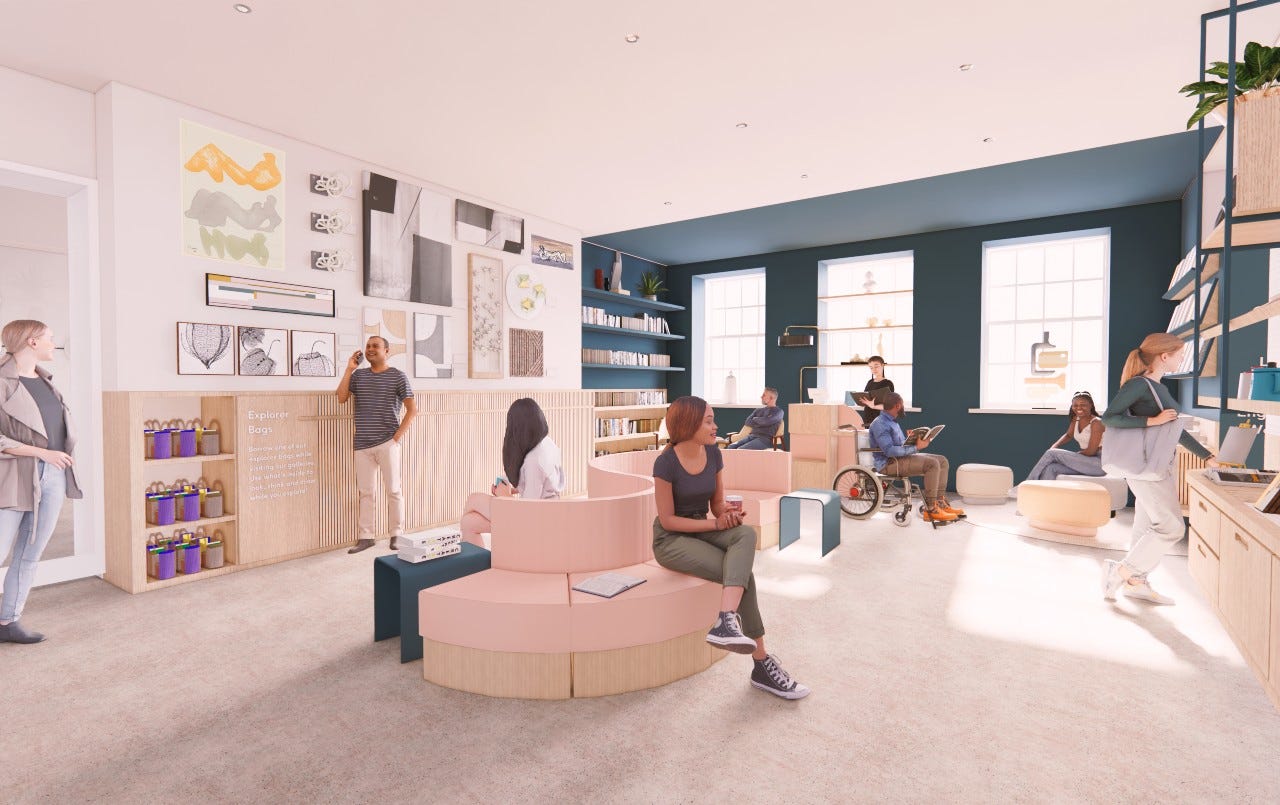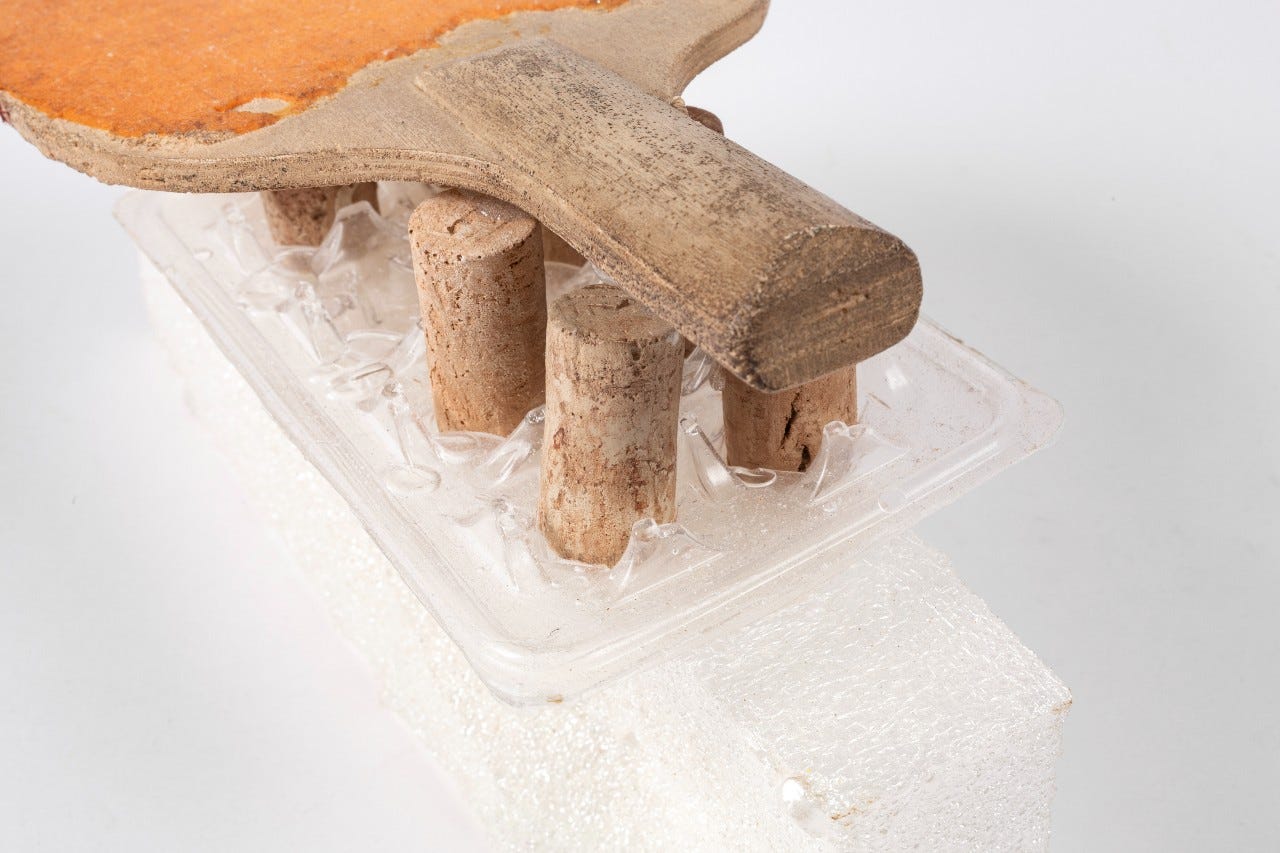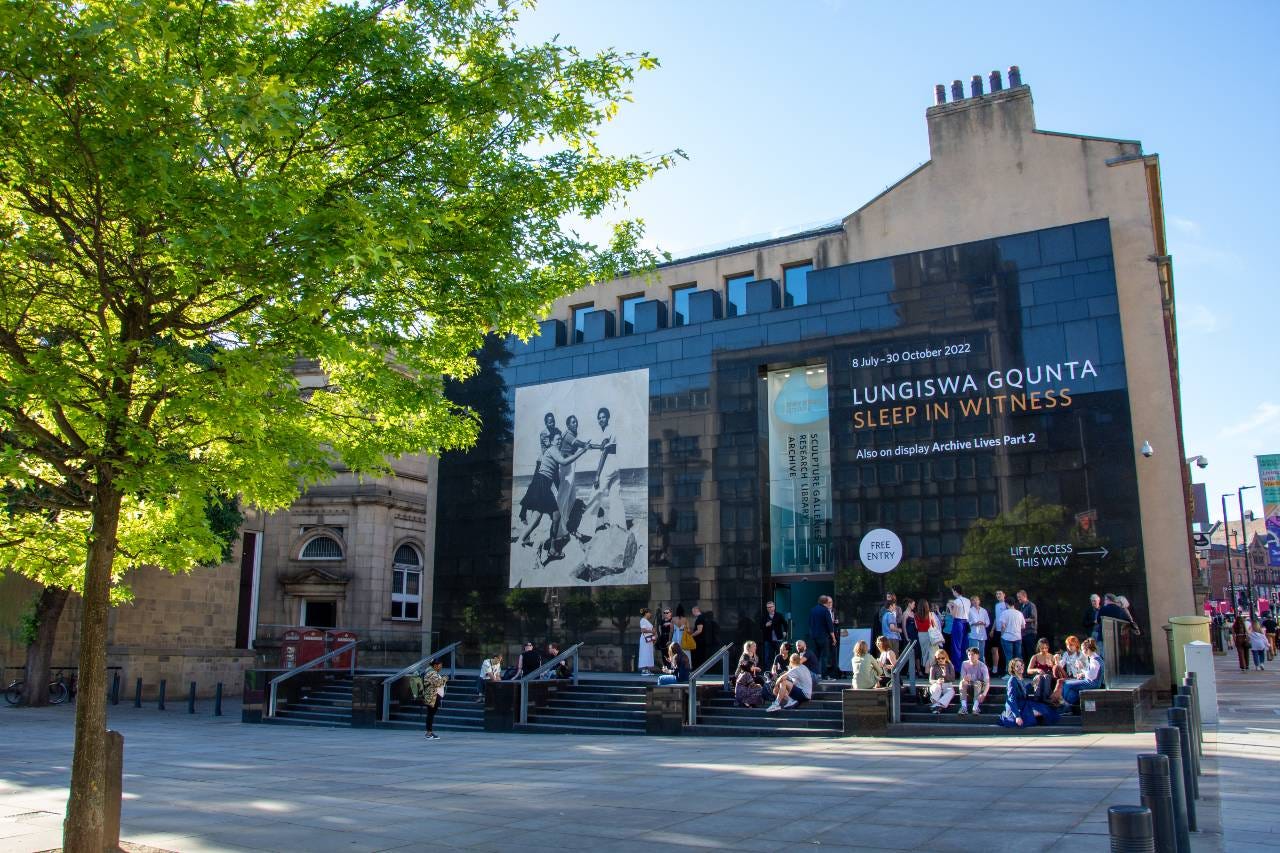— In partnership with Smartify
Hello.
It’s Tuesday, which means it’s ‘views and interviews’. You’re welcome.
Have you heard of a little thing called AI? Well in my 250 Take, culture and technology expert Chris Michaels urges museums to start embracing the new technology — and he provides three easy tips on how they can start.
My Big Interview is with the Head of the Henry Moore Institute in Leeds as it prepares to reopen after a revamp marking its 30th birthday as a global hub for sculpture.
And my Hot List features six queens, two American artists, and a new book on one of the world’s most eclectic collections.
Let’s dive right in!
— maxwell
ps. don’t forget to support my sponsors — they help me keep writing.
— In partnership with Smartify
This is how you help your visitors
Visitors are having a better experience in museums and galleries, thanks to Smartify.
Because it’s used by over five million people at more than 700 venues across the world, Smartify has unparalleled knowledge and insights on what visitors want. And they put those learnings straight back into their tech.
So whether it’s bringing objects to life through augmented reality, giving individual visitors personalised itineraries powered by AI, or creating digital experiences based on highly specific locations within a venue, Smartify is leading the charge of giving modern visitors what they really want. All of which means they connect better with your collection, spend more when they visit and return more often.
Smartify is ready to help your organisation, no matter its size: every tech solution can be fully customised to suit your brand or your specific needs.
Click here to let Smartify help your visitors, and you.
The 250 Take
This week my 250-word opinion column from a guest writer is penned by Chris Michaels — former Director of Digital, Communications and Technology at the National Gallery — who urges museums not to be left behind by the AI revolution.
💬 Museums should unlock the benefits of AI — here are 3 ways to start
“The world changed in 2022 when Open AI released Chat GPT 3 — software that by the end of January 2023 had been used by 100 million people globally.
Generative AI able to both process and create information has since become THE defining topic about how technology will shape tomorrow.
Generative AI is re-engineering how the internet works, and may be causing a shift in the relationship between humans and technology more substantial than anything since the Industrial Revolution. And there are complex ethical and IP questions still to answer.

But museums have been experimenting with AI for many years in collections research. Yet now AI is being integrated into every digital tool we use, it is time to act.
Don’t know where to start? Here’s three key things you can do today to start unlocking the benefits of AI:
Summarising. Museums spend A LOT of time writing minutes and notes. AI is GREAT at this. Use the transcription tools in Teams or Zoom to summarise your meetings and get back HOURS of someone’s week.
Kickstarting creative thinking. AI chatbots are useful at the difficult point between nothing and something. If you’re writing a document, doing design or even just sending an email, use AI to trial different approaches and take the pain away.
Human-machine research. Trained on the entire history of the internet, AI’s are brilliant for researching broad-topics, and condensing the outputs into high-level formative research.
Acting today means understanding the future as it unfolds.
The time is now.”
is a strategy consultant and advisor to cultural, creative and research organisations. He’s Deputy Chair of English Heritage and sits on the digital advisory boards of the BFI and the National Gallery. Subscribe to his newsletter Creative R&D: Art / Ideas / Technology.The Hot List
My curated round-up of what’s new to see, do, watch, read and more. From the UK — and around the world.
*Purchasing through links in this section may earn me a valuable affiliate commission
EXHIBITION
1️⃣ Six Wives: The Stories of Henry VIII’s Queens | National Portrait Gallery, London
In the NPG’s first exhibition of historic portraiture since reopening, the lives and afterlives of the six women who married Henry VIII are in the spotlight. Facts and fictions are examined through exciting objects.
now open — until 8 September 2024 | book your tickets
BOOK
2️⃣ John Soane's Cabinet of Curiosities | by Bruce Boucher
Much is known of Sir John Soane’s architecture, but little about what drove him to collect. Former Soane Museum Director Bruce Boucher changes that with this in-depth study of Soane’s motivations and strategies.
out now — published by Yale University Press | buy your copy
EXHIBITION
3️⃣ Igshaan Adams: Weerhoud | the Hepworth, Wakefield
The South African artist’s exhibition features newly commissioned pieces and existing work, including one of his largest and most immersive ‘cloud’ installations ever. The Times calls it “spectacular.”
now open — until 3 November 2024 \ find out more
EXHIBITION
4️⃣ Andy Warhol & Keith Haring. Party of Life | at Museum Brandhorst, Munich
The very first museum exhibition dedicated to the two giants of 20th century art, artworks, photographs and collaborative pieces will show how they blazed a trail in New York City in the 1970s and 80s.
opens 28 June | find out more
The Big Interview
Henry Moore was one of the greats, so it’s only fitting that the UK has two institutions dedicated to him. There’s his former Hertfordshire home and studios which is now a magnificent open-air museum of his work.
And there’s also the Henry Moore Institute in Leeds. Not a museum or gallery as such, but a centre for the study of international sculpture in the city where Moore began his training. The Institute has just turned 30, coinciding with hitting a milestone 1 million visitors over that three decades.
And like all sensible 30 year olds, the organisation decided they needed to future-proof their physical infrastructure. (If only I’d had that foresight all those years ago). They closed their doors towards the end of last year to fix and improve their Grade II listed home. In just over two week’s time they will reopen, glow-up complete.
They’ll also mark the reopening with the very first European solo exhibition by Hany Armanious, one of Australia’s leading sculptors. It’s all part of the Institute’s renewed remit to champion the medium and its developments from all over the planet.
So to find out Moore (apols) my interview today is with the Institute’s Head Laurence Sillars, who has led the organisation since 2017. Here we chat about what’s new for visitors, how they programme their exhibitions, and — with the election 9 days away —what the next government could do to best help organisations like his.
***
Hi Laurence. Excitingly, you're about to reopen. So what's new?
The Institute feels different from the moment you enter, with a completely new welcome area.
Our work with schools and young people through our Engagement Programme has grown enormously in recent years and the biggest change is a new, beautiful and light-filled studio for those visitors — suitable for messy making as much as talking.
Our research library has a new entrance lobby, our seminar room has been completely refreshed and, while perhaps less exciting, new toilets throughout the building and the removal of 30 years of filler and the refinishing of our gallery walls all add up to make this a very significant step-change in our offer.
What visitors might not notice is the work that has happened behind the scenes to enhance our sustainability efforts. We have installed solar panels on the roof and have been committed to using environmentally friendly materials and practices throughout from repurposing parts of the building to new staff uniforms.
Tell me about the opening exhibition — what will visitors see and learn?
Hany Armanious: Stone Soup is the first major exhibition in Europe of the Australian sculptor. It will span his entire career and include around 30 works.
Armanious moved to Australia from Egypt as a child and has spoken of needing to relearn the world through its material language as much as its spoken one. He makes near-perfect replicas of found objects through a delightfully precarious casting process using pigmented resin.
His work unravels any certainty of truly knowing the world through its things, but also reflects upon the joys of encountering objects for the very first time — all those responses to form and touch that rattle through your subconscious. Chunks of pavement, discarded noticeboards, collections of burnt-out candles, sections of decorative fencing are all fair game subject-wise, rekindled almost as paintings in their new guise. Once you tune into his way of looking, you never quite experience the world in the same way again.
How do you programme exhibitions? What do you consider?
Often working with guests scholars, we facilitate new research and are excited by the lenses it can provide to look afresh at narratives that have been previously overlooked.
We’ve just started a multi-year research project called Beyond the Visual that aims to enhance blind people’s experience of art in museums. It will culminate in 2025 with the first major UK exhibition showcasing sculpture predominantly made by blind or partially blind artists and is rare in having a blind curator as intrinsic to the project.
In 2022 we presented The Colour of Anxiety: Race, Sexuality and Disorder in Victorian Sculpture which linked the introduction of colour and new materials in sculpture to a sense of anxiety in Victorian society due to social change and scientific advances.
Similarly we want to present the best of sculpture being made today that hasn’t yet had widespread exposure. Our recent exhibition with South African artist Lungiswa Gqunta and that with Armanious sit in that strand.
The Henry Moore Institute is not strictly a museum — how do you describe yourself, and what is your mission?
At our heart we are a research centre and see it as our mission to bring a 360 degree appreciation of sculpture — be it through research, display or making — to as wide an audience as possible.
As well as a temporary exhibitions programme we have lectures, talks and conferences throughout the year (the majority of which are accessible online), a research library of 30,000+ books which grows daily, an Archive of Sculptors’ Papers which represents the working lives of hundreds of British sculptors through their notebooks, sketchbooks and a wealth of other ephemera, even materials, tools and artist’s book collections.
We also host visiting research fellowships for artists and scholars throughout the year. That’s all complemented by an engagement programme that enriches the visits of young people to the Institute and has relationships with schools, colleges and groups throughout the city and beyond.
Tell me about the partnership with Leeds Art Gallery.
The long-established partnership of Leeds City Council and the Henry Moore Foundation — of which the Institute is part — began with the development of the Sculpture Study Centre in Leeds Art Gallery in 1982 and led to the development of the Institute in 1993. It represents an unparalleled collaboration in the collection, study and presentation of sculpture. The City Council’s sculpture collection is housed at Leeds Art Gallery and encompasses finished sculptures, maquettes, models and works on paper. It lies at the heart of our work together and is complemented by the curatorial and research expertise of the Institute.
Together we grow knowledge and understanding of works in the collection, curate displays, oversee collection growth and integrate these activities with the Archive of Sculptors’ Papers, the Sculpture Research Library and the Institute’s ongoing research programme.
As part of our reopening we’re launching a gallery dedicated to displays drawn from the Archive. Across the two sites we’re also presenting a number of new acquisitions that we’ve brought about collaboratively including work by Emii Alrai, Phyllida Barlow, Hew Locke and Ro Robertson. Some very exciting new acquisitions are also about to be announced!
A recent Art Fund report revealed that two-thirds of museum directors are concerned about funding shortfalls, up from half in 2022. Do you share this worry for your venue?
Everyone is feeling the impact of shortfalls and rising costs. Museums are well versed at maximising budgets and we’re no exception in thinking strategically and with great care when using our resources to have the greatest impact. Collaboration has been key, and sharing resources wherever possible, like our ongoing partnership with Leeds Art Gallery and within Yorkshire Sculpture International (a collaborative venture across the specialist sculpture venues in the county.)
We’re also aware of how especially difficult it is to survive as an artist right now, perhaps more than we’ve known for decades. We’re thinking hard about different ways to provide support and opportunity where it’s needed most from fellowships and residences to mentorships.
There's a general election next week. Whoever forms the new government, what would you urge them to do to best improve the UK's cultural ecosystem, including for venues like the Henry Moore Institute?
We need art and all creative subjects firmly back in the curriculum so they are prioritised at the earliest age. The benefits of these subjects to the mind, body — and economy — are so thoroughly proven it just needs to be fixed.
While capital investment is always good, there needs to be a complete rethink about revenue funding. We are blessed with amazing venues and collections in nearly every city, but we’re struggling like never before to maintain them, let alone grow them, largely without any significant increase in public funding for decades. But we can go so much further. For example artists are supported in many better ways in many other countries. I could go on…
Finally, what are your other tips for people to get a culture fix in Leeds?
It’s such a rich city for a culture hit. For sculpture lovers, beyond the Institute there’s Leeds Art Gallery and the nearby Hepworth Wakefield and Yorkshire Sculpture Park.
Away from sculpture there’s Phoenix Dance, Northern Stage, Northern Ballet, Opera North, The Leeds International Piano Competition and so many other venues and organisations doing ground-breaking things.
Or, just mooching about the city’s Victorian arcades is always uplifting, as is a visit to Kirkgate Market: it opened in 1822, is home to some 250 stalls and is one of the largest indoor markets in Europe.
The Henry Moore Institute reopens on 12 July. Hany Armanious: Stone Soup runs until 3 November, entry is free.
Enjoyed this newsletter? It took many hours to put together. Donate now to support me as I continue to bring you insights from the world of museums, galleries, art and heritage.







Thanks for letting me contribute Maxwell!